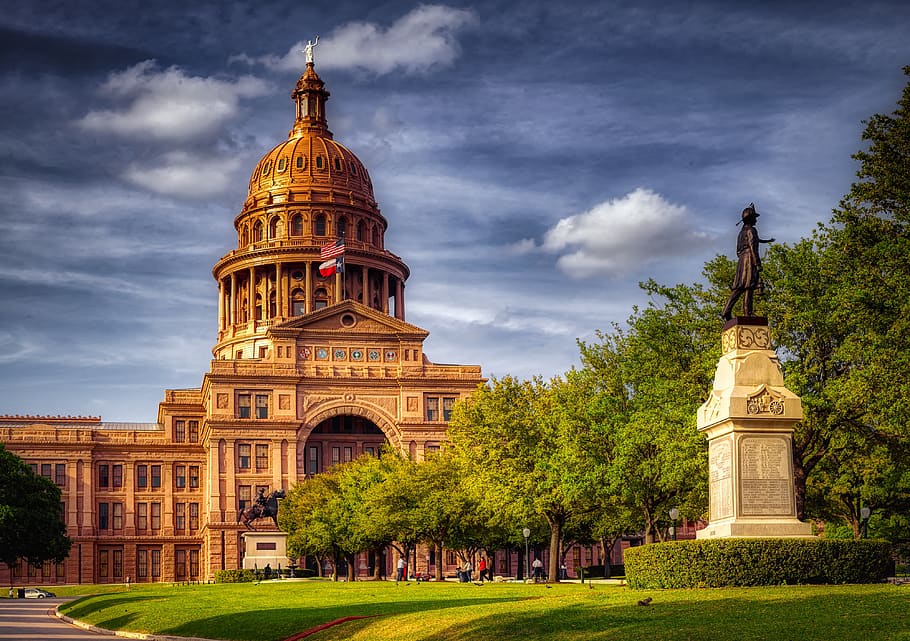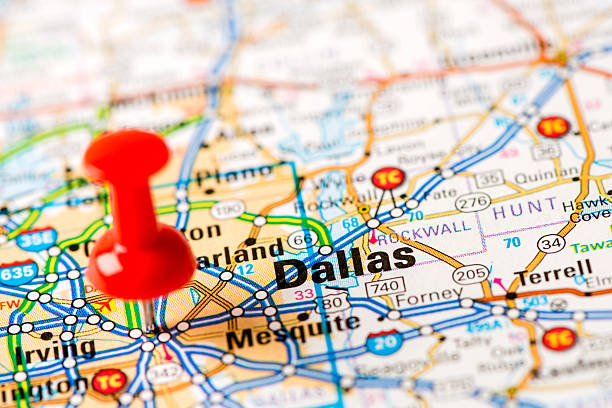
Texas
The ancestors of the West Texas Native Americans lived in camps perhaps as long as 37,000 years ago.
Possessing only crude spears and flint-pointed darts, these hunters survived primarily on wild game. In the more fertile areas of East Texas, some of the Native American tribes established permanent villages and well-managed farms and developed political and religious systems. Forming a loose federation in order to preserve peace and to provide for mutual protection, they came to be known as the Caddo confederacies. By 1528, when the first Europeans entered the interior of Texas, the area was sparsely settled, but the culture and habitation of the Native Americans exerted measurable influence on the later history of the region.
By the 1730s the Spanish had sent more than 30 expeditions into Texas. San Antonio, which by 1718 housed a military post and a mission (the Alamo), had become the administrative centre. With military support, missions were established in Nacogdoches in East Texas, in Goliad in the south, and near El Paso in the far west. The French also explored Texas. The explorations of René-Robert Cavelier, sieur (lord) de La Salle, and his colony at Matagorda Bay were the bases of French claims to East Texas.American colonization gained impetus when the United States purchased the Louisiana Territory from France in 1803 and claimed title to lands as far west as the Rio Grande. By 1819, however, the United States had accepted the Sabine River as the western boundary of the Louisiana Territory. Moses Austin secured permission from the Spanish government to settle 300 families on a grant of 200,000 acres (81,000 hectares) in Tejas (Texas).
When Mexico won independence from Spain in 1821, Austin's son, Stephen Austin, received Mexican approval of the grant. He led his first band of settlers to the area along the lower Brazos and Colorado rivers. By 1832 Austin's several colonies had about 8,000 inhabitants. Other colonies brought the territory's Anglo (European-descended American or European immigrant) population to about 20,000.Unrest throughout Mexico, including the territory of Texas, resulted in a coup by Antonio López de Santa Anna, who assumed the presidency in 1833.
Texans, hopeful for relief from restrictive governmental measures, supported Santa Anna. Stephen Austin expected a friendly hearing about these grievances but instead was imprisoned in Mexico City for encouraging insurrection. He was freed in 1835 and returned home to find that skirmishes had already developed between the colonists and Mexican troops and that Santa Anna was preparing to send reinforcements. Texans formed a provisional government in 1835, and in 1836 they issued a declaration of independence at Washington-on-the-Brazos.
David G. Burnet was chosen ad interim president of the new Republic of Texas; Sam Houston was appointed its military commander; and Austin became commissioner to the United States with the mission of securing strategic aid and enlisting volunteers.

The famous siege of the Alamo in San Antonio lasted from February 23 to March 6, 1836.
The strategic objective of the stand was to delay Mexican forces and thereby permit military organization of the Texas settlers. As the battle climaxed with a massive attack over the walls, the defenders (generally estimated to number between 183 and 189, though some historians believe the figure was larger) were all killed. Among the dead were the famous frontiersmen James Bowie and Davy Crockett. On April 21 Sam Houston led a surprise attack on the Mexican troops at the San Jacinto River, where he succeeded in capturing Santa Anna and in securing victory for the Texans.The Texas Revolution was not simply a fight between the Anglo settlers and Mexican troops; it was a revolution of the people who were living in Texas against what many of them regarded as tyrannical rule from a distant source. Many of the leaders in the revolution and many of the armed settlers who took part were Mexicans.The Republic of Texas was officially established with Sam Houston as president and Stephen Austin as secretary of state. Cities were named in their honour; Houston was the capital until 1839, when Austin was approved as the permanent capital.
The republic had a difficult 10-year life.
Financing proved critical, and efforts to secure loans from foreign countries were unsuccessful. Protection against raids from Mexico and occasional attacks by Native Americans required a mobile armed force. During the republic a squad of armed men, the famous Texas Rangers, was maintained to ride long distances quickly to repel or punish raiding forces.
The U.S. annexation of Texas and a dispute over the area between the Rio Grande and the Nueces River brought about the Mexican-American War. U.S. troops invaded Mexico in February 1847, and Winfield Scott captured Mexico City on September 14, 1847. In the Treaty of Guadalupe Hidalgo, signed on February 2, 1848, Mexico gave up its claim to Texas and also ceded area now in the U.S. states of New Mexico, Utah, Nevada, Arizona, California, and western Colorado. Texas claimed most of this additional area but later relinquished it in the Compromise of 1850.The American Civil War brought disruption to the state. Texas had seceded from the Union on January 28, 1861. Gov. Sam Houston had strongly opposed secession, and, after refusing to take the oath of allegiance to the Confederacy, he was removed from office. During the war Texans had to defend themselves from attacks by Native Americans, from Mexican encroachments, and from federal gunboats and invading soldiers. Federal forces ultimately gained control of the lower Gulf Coast but were unable to move far inland.

During the last three decades of the 19th century, there were rapid developments in the population and economy of Texas. The state was readmitted to the Union under a new constitution in 1870. By 1875 the Comanche had been forced onto a reservation in present-day Oklahoma. With the arrival of immigrants, towns were established, farming spread throughout the central areas of the state, and the cattle industry began to thrive on the plains of West Texas. Railroad building and increased shipping fashioned new links with the rest of the world. Manufacturing, encouraged by the Civil War years, continued to grow. By 1900 the population had grown to more than three million.
The enormous oil gusher that blew in at Spindletop (Beaumont) in 1901 opened a new economic era for the state. Oil companies were formed; oilmen began to search for and find new deposits in the state; and refining and marketing activities provided new jobs and incomes for Texas. Texas suffered throughout the Great Depression of the 1930s but later benefited from the tremendous industrial expansion that took place during World War II.Economic and population growth continued in the postwar era. Oil refining, chemicals, and petrochemicals continued to dominate, but electronics, aerospace components, and other high-technology items became increasingly important in the last quarter of the 20th century. The population of Texas increased fourfold between 1900 and 1980, when one-third of all Texans were either African American or Hispanic. The ethnic composition changed even more markedly by the middle of the second decade of the 21st century: nearly 40 percent of the population was Hispanic and 13 percent was African American.
Since the mid-20th century, Texans have played an increasingly important role in national politics. Sam Rayburn, of Bonham, served as speaker of the U.S. House of Representatives for 17 years, a tenure longer than that of any other person. Lyndon B. Johnson, who earlier had served as a Texas congressman, was majority leader of the U.S. Senate in the late 1950s, vice president of the United States from 1961 to 1963, and president from 1963 to 1969. In 1988 George H.W. Bush of Houston, who had served as vice president of the United States from 1981 to 1989, was elected president, and he served until 1993. His son George W. Bush served two terms as governor of Texas and was president of the United States from 2001 to 2009.
Mid-1519 – Alonso Alvarez de Pineda, a Spanish adventurer, sailed from a base in Jamaica to become the first known European to explore and map the Texas coastline.
November 1528 , Cabeza de Vaca shipwrecked on what is believed today to be Galveston Island. After trading in the region for some six years, he later explored the Texas interior on his way to Mexico.
1540-1542 , In search of the fabled Seven Cities of Cibola, Francisco Vasquez de Coronado led an expedition into the present southwestern United States and across northern Texas.
February 18, 1685 , Robert Cavelier, Sieur de LaSalle established Fort St. Louis at Matagorda Bay, and formed the basis for France's claim to Texas. Two years later, LaSalle was murdered by his own men.
April 22, 1689 , During an expedition planned to reestablish Spanish presence in Texas, Mexican explorer Alonso de Leon reached Fort St. Louis and found it abandoned. The fort was originally was established in 1685 by explorer Robert Cavelier de La Salle during the French colonization of Texas.
1716-1789 , Throughout the 18th century, Spain established Catholic missions across Texas including as well as the towns of San Antonio, Goliad, and Nacogdoches. One of the missions, San Antonio de Valero later became The Alamo.
August 8, 1812 , The Gutierrez-Magee Expedition with about 130 men, crossed the Sabine River from Louisiana in a rebel movement against Spanish rule in Texas.
1817-1820 , Jean Laffite occupied Galveston Island and used it as a base for his smuggling and privateering operation.
January 3, 1823 , Stephen F. Austin received a grant from the Mexican government to lead roughly 300 families to the Brazos River to begin colonization

The mission of the Texas State Historical Association (TSHA) is to “foster the appreciation, understanding, and teaching of the rich and unique history of Texas and, by example and through programs and activities, encourage and promote research, preservation, and publication of historical material affecting the state of Texas.”
TSHA is the oldest learned society in our state. Organized in Austin on March 2, 1897, the founders of TSHA brought lay and professional historians together to document and celebrate the state's complex and diverse history. Today, TSHA follows the path laid out by its founders, sharing Texas history and stories of events and people from all walks of life with individuals and organizations across the state, nation, and globe. It supports educational materials and other scholarship that follow the tenets, methods and practices advocated by the professional historical community.
We will continue to expand our efforts to include all accurate and inclusive histories in TSHA books, the Handbook of Texas and its special editions, the Southwestern Historical Quarterly and our entire range of educational materials and conferences.
In addition, we are involved with educators and students throughout the state who are enthusiastically engaged in these initiatives: Texas History Day, Texas History Challenge, Teaching Texas, Junior Historians of Texas, and the Walter Prescott Webb Historical Society.Archaeological Association was formed on December 2, 1973, in San Antonio at a meeting of forty charter members. The purpose of the organization was to promote the study of prehistoric and historic archeology in southern and south central Texas. At the founding meeting, it was agreed that the association would issue a newsletter, meet on a quarterly basis, and carry out such archeological activities as survey, salvage, and problem-oriented studies. Membership was open to both avocational and professional archeologists; subsequent membership forms contained an ethics statement in which members promised not to engage in the buying or selling of artifacts or to carry out untrained digging at sites.